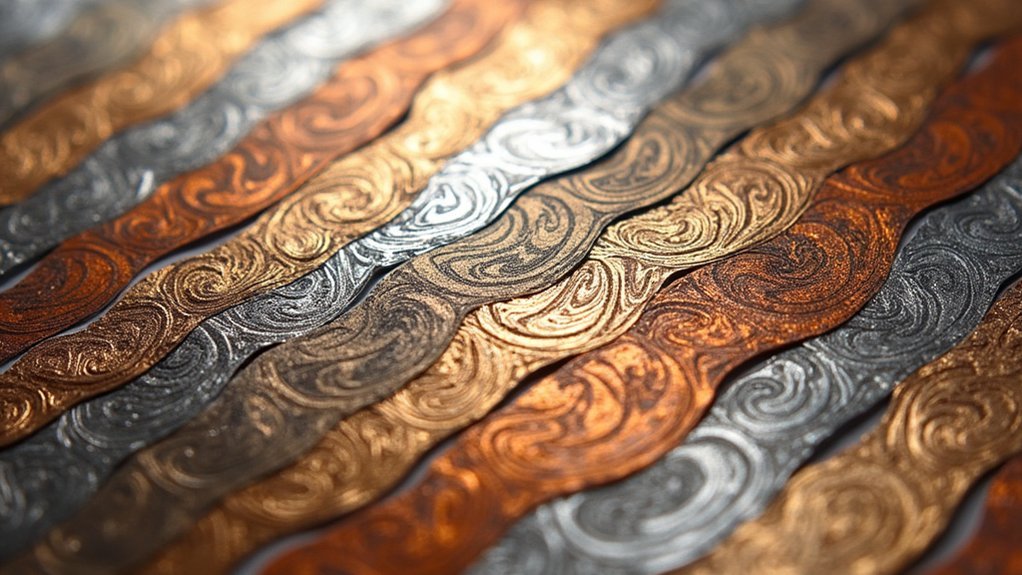You’ll achieve mokume gane success by selecting compatible metals with similar thermal expansion rates—copper pairs excellently with silver and gold alloys, while you should avoid high zinc brass due to brittleness. Master temperature control between 1200°F to 1700°F, using activated carbon in your kiln to prevent oxidation. Create stunning wood grain patterns by strategically manipulating bonded layers through twisting for spirals or rolling mill compression for linear striations. These foundational techniques reveal endless creative possibilities ahead.
Selecting Compatible Metal Combinations for Optimal Bonding

When working with mokume gane, you’ll find that selecting compatible metal combinations forms the foundation of successful lamination and bonding. You should prioritize metals with similar thermal expansion rates to prevent warping during heating and cooling cycles.
Copper and its alloys make excellent choices when paired with silver and gold alloys, creating striking contrasts while ensuring strong adhesion.
Choose fine silver over sterling silver for superior ductility and oxidation resistance during the layering process. This compatibility enhancement greatly improves your results.
However, avoid high zinc brass alloys, as they’ll cause brittleness and bonding issues during forging. Always test small samples of your chosen metals combinations first to verify their compatibility and bonding effectiveness before committing to larger projects.
Mastering Temperature Control During the Lamination Process
Getting the temperature just right separates successful mokume gane from costly mistakes during lamination.
Temperature control during the lamination process requires careful attention to prevent overheating, which causes metal loss and unwanted liquid phases, or insufficient heat that results in poor bonding.
Precise temperature control prevents costly overheating that destroys metals while ensuring sufficient heat for proper lamination bonding.
You’ll need to determine the ideal firing temperature through testing small pieces first. Different mokume gane metals have varying eutectic points, so what works for one combination won’t necessarily work for another.
Typically, temperatures between 1200°F to 1700°F work well for copper, silver, and gold combinations.
Monitor your heating process closely to prevent oxidation from prolonged exposure.
Create a reducing atmosphere in your kiln using activated carbon to minimize oxidation and preserve your metals’ color and quality.
Creating Distinctive Wood Grain Patterns Through Strategic Layer Manipulation

Once you’ve mastered temperature control for successful lamination, the real artistry begins with manipulating your bonded layers to create stunning wood grain patterns. Strategic layer manipulation transforms your Japanese metalworking project into something extraordinary.
Select contrasting metals like copper alloys and silver—their color naturally patinates differently, enhancing pattern visibility. Thinner layers produce intricate details, while thicker ones create bolder designs. Clean surfaces guarantee proper diffusion bonding under controlled heat.
| Technique | Result |
|---|---|
| Twisting | Spiral grain patterns |
| Rolling mill compression | Linear striations |
| Varied layer thickness | Depth variation |
Your rolling mill becomes essential for manipulating surfaces. Copper alloys offer excellent working characteristics for beginners. Remember, achieving distinctive wood grain patterns requires patience—each twist and compression reveals new possibilities in your evolving wood grain masterpiece.
Frequently Asked Questions
What Metals Are Best for Mokume Gane?
You’ll find copper alloys like shakudo, silver alloys including fine and sterling silver, and 18K green gold work best for mokume gane. They offer excellent workability, bonding properties, and beautiful color contrasts when properly laminated together.
Are Mokume Gane Rings Durable?
You’ll find mokume gane rings quite durable when they’re made with proper alloys and techniques. Avoid high-copper combinations that corrode easily, and you’ll enjoy your ring’s beauty for years with basic care.
Why Is Mokume Gane so Expensive?
You’re paying for premium metals like gold and silver, plus skilled artisans who spend days handcrafting each unique piece. The specialized techniques and rare alloy combinations make mokume gane jewelry exceptionally expensive.
How to Polish Mokume Gane?
You’ll start with 400-600 grit sandpaper, then use a rotary tool with buffing wheel and metal polishing compound. Clean with microfiber cloth, apply metal wax for protection, and maintain regularly.
In Summary
You’ll achieve stunning mokume gane results by carefully selecting metal pairs that bond well together. Control your heat precisely during lamination to prevent warping or separation. Don’t rush the layering process—strategic manipulation creates those coveted wood grain effects that make each piece unique. Practice these fundamentals consistently, and you’ll develop the skills needed to craft beautiful mixed metal pieces that showcase the true artistry of this ancient Japanese technique.





Leave a Reply